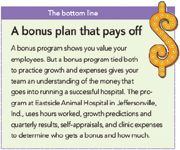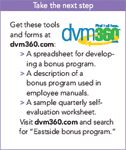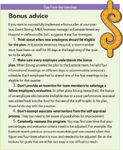A winning bonus program
This bonus program rewards employees fairly.
When our practice is at its best, we want to reward the team that makes it happen. So we've implemented a bonus program—a quarterly system that takes into account practice growth, individual performance, and cost control. Here's how our plan works. Eastside Animal Hospital in Jeffersonville, Ind., come on down!
A prize for growth
Every quarter we set new growth goals—an increase on what we did during the same period from the previous year. For example, if our income in the second quarter of 2007 was $250,000, we might set a growth goal of 7 percent for the second quarter of 2008, which comes to $17,500 in additional income. We pay out bonuses to support staff and associate veterinarians based on that growth figure. The bonus amounts correspond to our ideal spending on compensation as a percentage of our total income.

The bottom line
For support staff, let's say we pay 20.8 percent of our growth goal to team members divided proportionately according to the hours they worked that quarter. So if we paid 20.8 percent of $17,500, the team would get $3,640. For associate veterinarians, we might use 8.9 percent to calculate the amount paid. If practice growth exceeds the goal, we still pay the bonus based on the goal, not the actual percentage of growth. Visit dvm360.com and search for "Eastside bonus program" to download a spreadsheet that illustrates how we calculate each team member's share of the bonus.
A reward for performance
With more than 30 team members on our payroll, we quickly realized that success can be very expensive. Not long after launching the program, we paid out more than $10,000 two quarters in a row. Growth had been robust, however, so the cost was worth it to see our employees satisfied. "I think the program has helped us learn to work together as a team," practice manager Julia Marlin says. "It's an incentive for us to focus on everything we do."

Take the next step
And the incentive played a big part in our growth. From September of 2006 to the end of 2007, our revenue increased by 11.83 percent. Compare that to January through August of 2006—just before the program began—where we saw little or no growth. Nevertheless, it was clear that we needed to consider some additional factors in case our costs rose faster than our income, or in case some team members were doing more work than others.
In essence, team members were getting a raise of 60 to 65 cents per hour as a result of the bonus program. That's not a bad raise by most standards, but did everyone deserve it? To determine this, we created a monthly performance appraisal system that requires team members to fill out a two-page self-assessment form at the end of each quarter. To encourage team members to put some thought into the self-assessment process, we ask them on the form to cite examples of their performance. We recognize that some employees tend to overestimate or underestimate their value to the company, so if needed, a manager meets with those team members to tweak the score. But it's been our experience that the majority of the self-appraisals require a quick approval and nothing more. The final score on the appraisal affects the percentage of the share that team member receives. Visit dvm360.com and search for "Eastside bonus program" to download a sample employee self-assessment form and to see our growth bonus incentive plan.

Tips from the trenches
A gift with strings attached
A business's health has as much to do with expenses as it does income. Our bonus program reflects this. Excessive spending in some areas can reduce the amount of the bonus fund. We're careful to consider only the expense categories that the team has some control over. For instance, they can't do much about rent, insurance, electric bills, or credit card fees. Here are the expenses we do include in our bonus plan:
Support staff compensation. The percentage of our overall income that we spend on support staff pay fluctuates significantly by quarter, so we set different cost objectives for each quarter based on practice history. Our yearly support staff compensation may total 20.8 percent of our total income, but the first and third quarters always exceed this, so the bonus program is adjusted accordingly.
For example, our second-quarter budget objective for support staff costs is 17.5 percent or less of total income. Any percentage in excess of this at the end of the quarter is deducted from the percentage of the bonus payout. If we spend 18.5 percent on support staff, we've exceeded the goal by 1 percent, therefore we reduce the bonus from 7 percent to 6 percent. Did we hire new people, add a licensed veterinary technician, or pay a lot of overtime? If so, these investments need to pay off through increased productivity. We strive to accomplish this by stressing proper planning by managers, efficiency in the workplace, and team member attendance at all training meetings.
Cost of goods sold. We spend about 22 percent of our total revenue on drugs, medical supplies, laboratory supplies and services, pet food, and kennel supplies. If we exceed 22 percent in a quarter, then we reduce the bonus amount by the same percentage. Did we forget to charge for a service? Did we throw in some food at no charge? Were we inconsistent in our recommendations to the client? "Yes" answers to these questions hurt company performance.
Office supplies and printing. This cost is a very small percentage of our income—about 1.2 percent—but it's an area of potential savings or waste. We try not to waste paper. We e-mail pay stubs and in-house newsletters to most team members and print internal documents on the back of used paper. For each tenth of a percent that we exceed 1.2 percent, we reduce the bonus payout 1 percent.
Accounts receivable. We average our monthly accounts receivable balances at the end of each quarter. If that average exceeds our goal, in our case $16,000, this reduces the bonus plan fund by the same amount as the overage. Did we extend credit to unproven clients? Did we fail to ask for a significant deposit for a hospitalized patient? When the answer is yes, we're asking for losses.
Write-offs. Uncollected debts are more than just lost revenue. All the costs associated with these accounts wipe out the profits made on a fairly large number of good accounts. If write-offs for the quarter exceed our set limit, we reduce the bonus plan by the amount of the overage. Our office manager has a great deal of control over when we abandon collection efforts, but eventually we, the management team, must make that decision.
Major equipment repair. If we accumulate unexpected repair or replacement costs in excess of $5,000 in a quarter, we reduce the bonus plan payout by 50 percent. If those expenses exceed $10,000, we abandon the bonus program for that quarter. But there's some judgment involved here. For example, our phone system needs to be replaced—a $7,000 expense—but we won't hold the bonus plan hostage because this is an anticipated expense. On the other hand, if someone breaks an expensive piece of equipment for which we don't have a service contract, that would affect the bonus plan.
The cumulative effect of all these cost-based modifiers on the plan could potentially whittle the funds to nothing—but they shouldn't. Practice growth resulting from a solid team effort will keep cost factors within reasonable boundaries. If it doesn't, we shouldn't be paying the full share of the growth incentive.
Our bonus program is one of many efforts to improve our company's performance, including marketing and branding efforts, consistency in following medical protocols, and hiring quality team members. We strive to combine solid business practices with better client and patient care. For us, that's a winning combination.
David Strong, MBA, is the business manager at Eastside Animal Hospital in Jeffersonville, Ind.
Send questions or comments tove@advanstar.com